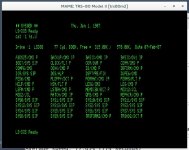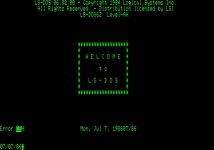OK, I get the hint. I'll make a list of what I have and post it up for comment. I'll then image in order. It's about time. Most of what I have is for the 16 series running Xenix, but I do have some II specific stuff.
+ 1 !
OK, I get the hint. I'll make a list of what I have and post it up for comment. I'll then image in order. It's about time. Most of what I have is for the 16 series running Xenix, but I do have some II specific stuff.
Everyone,
The community is small, but there are at least 5 people on the board that I know of who have unique 8in media that has not been imaged. I'm sorry if that sounds curmudgeonly, but I'm not wellBy my count at least 95% of the images in pski's model2archive came from me, beit directly or indirectly. Please people image and share! *cough* *sneeze*
@Lamar
I do have the source code for LS-DOS 6.2, but no disc image. I'm pretty sure Pete can image 8in, but I'll let him respond to that. Yes, the code for 6.2ßAC is a bit of a nightmare, and disassembled 6.3.1A code does show a lot of fixes and bugfixes.
It's good that FDIV is in contact with someone, I feared the worst for a while. I'm very happy that he's going to share what he can, when he can.
It was because of Frank Durda's challenge stating that "it couldn't be done - certainly not in BASIC!" - ... Everything is fine, except when the DMA and FDC is involved or INTerrupts are enabled... then it becomes a somewhat capricious beast, not unlike a real Model II.
Even when following the logic of some of the Model II boards, there is endless try-and-fail to accurately emulate some things, because the Model II boards aren't doing what they are supposed to.
The Arcnet process is commented out to a stub, because that board's wacky interfacing to its memory and the 80C26 had so many many problems I gave up (I will deal with it later). Ask Frank about Arcnet boards - I dare you!...
How do you go about getting a ROM added to MAME?
..... and I have the temperature-controlled solder/desolder/hot-air rework station...
@Iowen
You got the right tools to do the job, but be very careful with the PCB it is of a very bad quality and the soldermask
doesn't work anymore after all those years.
(I had to replace the XR chips on my keyboard, which was a terrible job)
I hope you can read the data and improve Mame. :D


That'd be from the lubricant drying out on the disk sleeve - generally the precursor to an all-out oxide dump, so you're lucky there.pski said:I guess we got lucky with the LS-DOS 6.2 disk because it squealed like a pig when I started imaging, but it did complete successfully. Not sure if I can image it again successfully, but hopefully what we got exactly was what was on the disk. I'm not sure how good the error correction and/or read verification is in ImageDisk.

This is basically a beta port of TRSDOS 6.2 for the Model 4.lowen said:This is what LSI wanted TRSDOS 6.2 to look like for the Model 4
I guess we got lucky with the LS-DOS 6.2 disk because it squealed like a pig when I started imaging, but it did complete successfully. Not sure if I can image it again successfully, but hopefully what we got exactly was what was on the disk. I'm not sure how good the error correction and/or read verification is in ImageDisk.
...
This is basically a beta port of TRSDOS 6.2 for the Model 4.
LS-DOS 6.3.1A has in the same place (from 10h): "LS-DOS63Level-1A"
Now it will be interesting to see how much of the LS-DOS 6.2 code matches up to what's on this disk.
...
To solve the problem I have setup a new installation of Mame64 / Mess version 1.70....
Use mess interface version 1.70
Load image
Go to options
Click hard reset
Click soft reset
View attachment 32325
...
Click hard reset
Click soft reset
...
Does anyone know how we could use different M2 boot roms in mame? The current trs80m2 rom folder(see below) has a bunch of different roms which seem to be the BINs of the M2 roms. Specifically, if I want to use a particular version of the boot rom, how can I tell mame to do that? Thanks.
